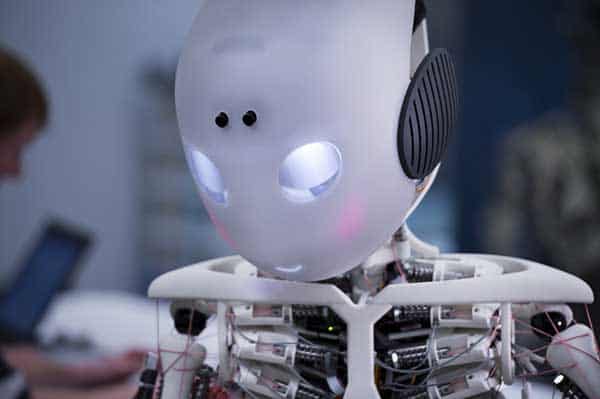Robotics is a rapidly growing field in engineering and manufacturing, and many useful robotic devices which mimic human behavior are emerging. It may be worthwhile to mention a few of these emerging robotic devices.
- Mechanical grippers are useful on product assembly lines, because they can reliably pick up, hold, and deposit components and parts needed to assemble a product.
- Rolling and tracked robotic devices are able to navigate in confined and dangerous environments. Certain types of such robotic devices which are equipped with bomb detectors have saved many lives in war zones, and have thwarted terrorist plots.
- Walking robots can be used in uneven and dangerous environments. In addition to performing functions similar to rolling and tracked robots, they can provide many domestic and industrial services, depending on the level of sophistication of their embedded software.
- Snake robots mimic the movement of snakes, and they can navigate in very confined spaces, both on land and in water. They could be used to search for victims in collapsed buildings after earthquakes. They could also be used in deep sea environments to search for wreckage.
Another field of robotics, termed “soft robotics” is benefiting tremendously from 3D printing (Additive Manufacturing). Soft robotics is the type of robotics which does not use rigid structural members. Instead, it uses easily deformable members which are constructed from fluids, gels, and elastomers that can match elastic and rheological properties of biological tissues and organs.
The role that 3D printing plays in soft robotics is the focus of the article. Topics and questions which are addressed are:
- Which types of applications need soft robotics?
- How is 3D printing used in soft robotics?
- How much progress is being made to utilize 3D printing in soft robotics?
Which Types Of Applications Need Soft Robotics?
Soft robotics is the type of robotics which makes all members of a robot soft and flexible. The flexible members enable the robot to move in very limited spaces and to change gaits fairly easily. The idea is to make the robot mimic the movement of an octopus squeezing through a narrow opening, or of a caterpillar rolling through uneven terrains.
Extrusion-based 3D printing makes it possible to print robotic members out of easily deformable materials such as viscous fluids, gels, and elastomers. Such deformable materials have properties which can be tailored to approximate those of living tissues and organs.
Applications which can benefit from synergism between 3D printing and soft robotics include actuators, sensors, and components that can move and conform to environmental shapes and constraints.
How Is 3D Printing Used in Soft Robotics?
Research projects are ongoing to develop the following devices which utilize 3D printed soft robotic members.
- IRobot demonstrated an interesting form of robotic locomotion dubbed “particle jamming skin” to create a robot known as the “blob bot”. The functionality of the robot was based on a unique particle jamming end effector (robot hand) for performing manipulations. By selective inflation and deflation, the particle jamming end effector can change from a liquid-like state to ooze around a target object and then harden into a solid-like state to grasp or pick up the object. A demonstration showed a robot with particle jamming end effector picking up medication, keys, and a (dummy) patient’s arm.
- Researchers at Cambridge University created an autonomous soft-bodied fish robot that is both self-contained and capable of rapid, continuum-body motion. The robot employs a compliant body with embedded actuators emulating the slender anatomical form of a fish. At the core of the fish’s soft body is an array of fluidic elastomer actuators that enable the fish to emulate escape responses in addition to forward swimming. Such maneuvers require rapid body accelerations and continuum-body motion.
- A company called Desert Star Systems has utilized 3D printing to create robotic tags for tracking different species of creatures in the ocean. The tags can track the habits of sea creatures and gather specific information on their behaviours. Because of the immense number of different types of species, it is necessary to design different shapes and sizes of possible tags. Desert Star Systems uses 3D printers to customize their tagging system for specific species of sea life.
- Advanced Solutions, Inc. recently released its six-axis 3D printer, Bioassemblybot. The printer combines 3D bio-printing technology with an advanced robotic arm, enabling the printing of biological tissues or organs. However, the printing of functional tissues or organs is at least five years away.
How much progress is being made in utilizing 3D printing in soft robotics?
Researchers at MIT have used 3D printing and soft robotics to build a three-fingered robotic hand that can identify and safely grasp delicate objects. Novel features of this robot include:
a) The ability of the fingers to conform to the shape of the object to be picked up, such as a piece of paper, a pencil, an egg, or a living thing such as a pet.
b) The ability to maintain a firm and secure grip without crushing the object being picked up,
c) The challenging task of embedding sensors in the soft silicone hand and equipping it with software that enables it to distinguish between different objects.
Researchers at Carnegie-Mellon have built a similar three-fingered robot.
The company Soft Robotics is creating tissue-compliant robotic surgical instruments that can access small spaces and be reconfigurable in that space. These types of soft robotic instruments reduce the likelihood of tissue damage during surgical procedures such as hysterectomies, prostrate removals, and other complex minimally invasive surgeries. 3D printing is used to print these soft robotic instruments from silicone and other deformable materials.
Conclusions
The technology of soft robotics is in its infancy, but because 3D printing can be used to print deformable materials, the potential for soft robotics is enormous. It may not be too long before soft robotic products emerge, such as prosthetic arms or hands that function almost as well as real living body parts.

